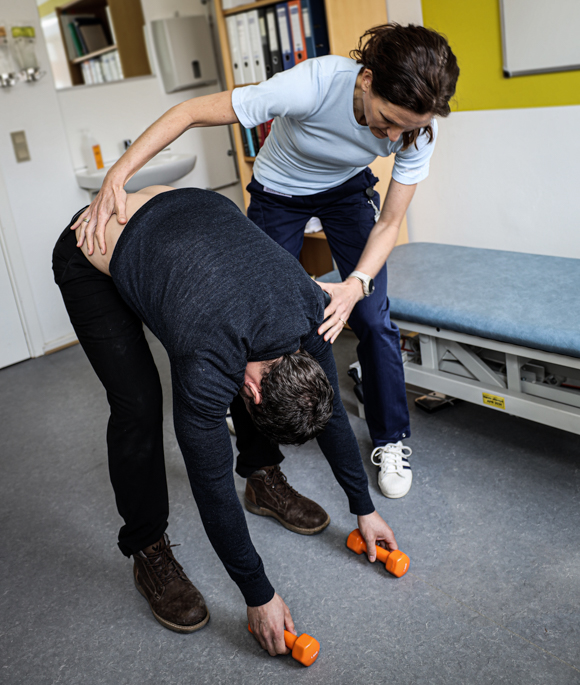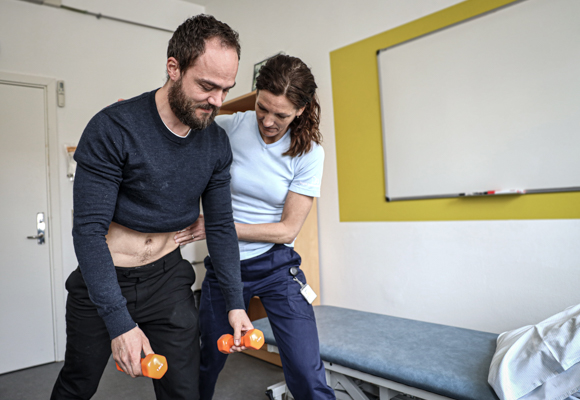
A new treatment gives hope to back patients
Researchers from the University of Southern Denmark have helped test a treatment that is effective for back pain patients who cannot be helped otherwise.
A new treatment for patients with chronic back pain tested in a research project, is not only effective, itis also affordable and has the potential to save the society millions of dollars.
Jan Hartvigsen, Professor and Head of Research at the Center for Muscle and Joint Health, Department of Sports Science and Clinical Biomechanics at the University of Southern Denmark (SDU), is one of the researchers involved in the project, whose results have just been published in one of the world's highest-ranking medical journals, The Lancet.
He has focused his research on helping people with chronic back pain for 25 years.
Facts about back pain
Back pain is the most common cause of early retirement in Denmark, accounting for 38% of all newly granted early retirements.
Globally, back pain is the most common reason why people cannot work or engage in leisure activities.
It is also one of the most common reasons why Danes see their family doctor, resulting in 4.5 million extra consultations with general practitioners, physiotherapists, and chiropractors every year.
In Denmark alone, the annual costs associated with back pain are approximately 28 billion Danish kroner.
”Many of the patients in this project had actually given up hope of finding a solution for their pain, but more than 80 percent of them experienced significant improvement
-Many of the patients in this project had actually given up hope of finding a solution for their pain, but more than 80 percent of them experienced significant improvement, he says.
Coaching and individualized movement strategies reduce pain
The treatment, which has been tested on Australian patients, is called Cognitive Functional Therapy (CFT) and consists of intensive coaching that helps patients make sense of their pain and trains them to move in ways that reduce pain.

-The results show that the participants not only experience less pain, they also gain new confidence in their ability to perform tasks at work and in their free time that they have often not been able to do for years, says Jan Hartvigsen.
Meet the Researcher
Jan Hartvigsen is professor, Chiropractor PhD at Department of Sports Science and Clinical Biomechanics.
”The results show that the participants not only experience less pain, they also gain new confidence in their ability to perform tasks at work and in their free time that they have often not been able to do for year
The participants received up to seven treatments over a period of 12 weeks followed by a booster treatment after six months. And the researchers have followed up on the effects a year later.

-This is a group of patients for whom we generally do not have good treatments. However, this treatment is life changing. And it's not just a quick fix! The remarkable thing about this treatment is that the results appear to be lasting, and that's a breakthrough.
Chronic patients test CFT in the Southern Denmark Region
Other researchers at SDU are already investigating the effects
of CFT treatment further.
At the Pain Center at Odense University Hospital, Professor Henrik Bjarke Vægter has recently completed a randomized trial where 130 patients with chronic complex back pain have tested whether CFT treatment is more effective and cost-efficient than the currently recommended interdisciplinary pain treatment offered at a specialized pain center.
-The patients participating in our study are among those who are most severely impacted by their pain condition and where existing treatments have very limited effects. These patients have significant functional limitations and are on the brink of leaving the labor market, says Henrik Bjarke Vægter.

-They often face psychological and social challenges, severe sleep problems, and have previously tried a long list of treatments in the health care system without success. We expect that CFT will be an important element in the treatment of chronic complex pain in the future.
A better life for less money
The test of the CFT treatment shows an average saving of 25,000
Danish kroner per patient in the first year. The savings arise
because the participants work more, take less medication, and
generally receive fewer healthcare services.
”Our results give hope to many patients who live with chronic back pain and who have so far not been able to get effective treatment in the healthcare system
Facts about the study
492 patients participated in the research project.
The study was conducted at Curtin University in Australia.
CFT was developed by Professor Peter O’Sullivan from Curtin University.
The first author of the article is Peter Kent, a lecturer at Curtin University and a former employee of the University of Southern Denmark.
Professor Jan Hartvigsen is a co-author and has helped design and conduct the study.
The study's results are published in the article "Cognitive Functional Therapy with or without movement sensor biofeedback versus usual care for chronic, disabling low back pain (RESTORE): a randomised controlled, three-arm parallel group, phase 3, superiority clinical trial".
Read the article online here.
Facts about Cognitive Functional Therapy (CFT)
Special training is required to perform CFT.
The treatment was performed by specially trained physiotherapists in the research project, but it can probably also be performed by other healthcare professionals with the same postgraduate education.
Specifically, the treatment consists of up to seven sessions where a clinician helps the patient understand what pain is in general and in their life - in other words, to make sense of the pain.
Next, patients are exposed to personalized exercises that help them move more naturally without pain and gain confidence that their back can be used for work and leisure. Maybe they can't do everything they want, but most can come a long way.
Finally, the focus is on positive lifestyle changes such as physical activity, social relationships, and mental health.
After receiving the treatment, patients can have a much better everyday life and they resume many of the activities they couldn't do before treatment. This can apply to both work and leisure. At the same time, they have less pain and more confidence.